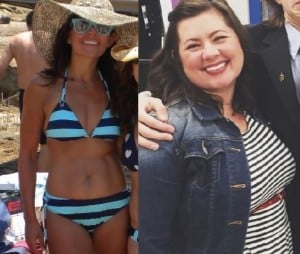It took me a long time to get the hang of sex.
And I don’t just mean “how to have sex with another person that leaves you both feeling great” – I mean how to be a sexual person at all.
It seemed to me that, for other people, getting caught up in sexual bliss was something that happened effortlessly, but I could be in the most romantic environment doing all the right things, and feeling only a tingle at best.
I grew up with a lot of sexual repression and fear, so I learned in early puberty to cut myself off from sexual feelings, and really from my body as a whole.
The result was that I was in my twenties before I even tried masturbating. To my dismay, it did nothing for me. It didn’t matter how or where I touched myself: all I felt was a little weird and self-conscious.
Reading books and magazines with sex advice didn’t help at all. Most of it was focused on “try this trick” or “use this toy,” which was useless to me. Even the better advice, like “communicate with your partner about what you like” and “don’t be afraid to explore your fantasies” was super unhelpful when my issue was that I didn’t even know what I liked.
To my surprise, what helped me break through was something that I never thought could be related to sexuality.
Before I move on, though, I want to give a shout-out here to all my asexual friends: Plenty of people aren’t into sex, and that’s just fine. I actually owe a lot to the asexual and demisexual community for giving me a safe space to figure out my feelings about sexuality without saying things like, “You mean you’ve never had a sexual fantasy?!” They were an awesome, supportive, accepting bunch, and they didn’t even hold it against me when, after a several-months journey, I concluded that I was sexual, just really, really disconnected.
Now, what turned things around for me was something I started doing for entirely different reasons: a meditation technique called a body scan.
The practice of sitting and quietly drawing attention to how my body felt made me realize just how disconnected I was from my body. It slowly awoke me to hundreds of subtle feelings that were happening all the time beneath my awareness.
It also helped open up the channel for sexual sensations – and slowly, I found myself experiencing pleasure or arousal at certain touches or certain thoughts.
The media will tell you that great sex means being wildly experimental, mastering just the right oral sex techniques, using lots of different positions. All of those can be part of making sex awesome. First and foremost, though, what makes sex great is being deeply connected with your body, and living fully in the sensations you’re feeling.
That level of body connection doesn’t come naturally to a lot of people.
Especially if you’re an up-in-your-head geek like me, or if you have a lot of guilt or shame attached to your body, or if you’ve absorbed the very Western notion that the physical is inherently inferior to the mental and spiritual, you may have a hard time being fully present and connected to your body.
Now, as a sex educator and writer, I never talk about “getting better at sex” or “improving your sex life.” Over and over, I talk about “connecting to your sexuality.”
It’s sort of an unusual phrase, but for me, it captures the actual heart of sexual pleasure: being deeply connected with your body, and living fully in the sensations you’re feeling.
3 Reasons to Connect Rather than Improve
1. It Helps You Drop the Yardstick
I have a really hard time not thinking in terms of how I measure up to other people: Am I better than him? worse than her? And I apply this to sex, even though I know that’s both silly and counterproductive.
Sure, sometimes sex is “wild rapture” and sometimes it’s “happy and comforting,” but “more intense” doesn’t always equal “better.”
And nothing kills sexual pleasure faster than worrying about whether it’s good enough.
When I work on connecting with my body, it doesn’t matter how I compare to anybody else, or to my own past or ideal experiences. All that matters is how I feel in this moment.
2. It Helps You Focus on How You Feel Instead of How You Look
Particularly for women, so much of talk about sex is about how to be sexually appealing to someone else, not how to feel sexual pleasure within yourself. You could read an entire issue of a magazine like Cosmo and not read one word about improving your own internal sexual experience.
This is bad enough, but the bigger problem is that we tend to internalize this focus on being sexy.
So often, during sex, I’ve been worried more about how sexy I look from the outside, rather than how I’m feeling and what I’m experiencing.
It’s taken a lot of conscious work to overcome this training and focus instead on how sex feels inside my body.
3. It Allows for Diversity
Here’s something you’d never know if you only got your sex info from popular magazines: Different humans are really different not only in what they find sexually appealing, but in what sexual pleasure feels like.
Take orgasm, for example. It’s hard to describe what an orgasm feels like, and part of the reason is that it feels different for different people.
I was two-thirds of the way through my human sexuality degree before I learned that the way I orgasm is one of several normal – and very different – patterns that people experience.
If I’d never gone to grad school, I might have spent my life assuming there was something wrong with my sexual functioning because of how orgasm works in my body. And I suspect that there are a lot of varieties and diversities in sexual experience that no class is teaching about.
The only thing that can tell you how your body’s supposed to work is your body. Connecting is a way of listening to what it has to say.
But how?
4 Ways to Practice Connecting with Your Body
Mindfulness practices that focus on body awareness are amazing ways to develop stronger connections to your body.
Many of them, particularly the body scan and walking meditation, come from the Buddhist tradition of vipassana meditation. And all of them use the basic idea of resting your attention on the feelings within your body, without judgement and without any particular goal: just becoming aware.
The most important thing is to be kind to yourself and do what’s healthy for you.
For some people, connecting to the body with awareness is especially difficult or fraught, due to body dysphoria, past trauma, or other factors.
What is a gentle and healing activity for one person might be triggering for another, so never feel the need to push yourself to do something that doesn’t feel right.
If you want to try these, but know that body awareness brings up issues for you, you might want to enlist a therapist or spiritual leader to give you some extra guidance and support.
1. Body Scan
This is what helped me break through those first barriers to experiencing my sexual self.
Like all meditation techniques, it can be done in different ways, but the essential practice of the body scan is sitting or lying still (I have to sit up or I get sleepy) and slowly moving your attention through your body, one part at a time.
As your attention rests on each part, you just notice what’s going on in that area of the body – how it feels, all the subtle sensations that you normally block out or ignore.
For me, a body scan is a deep and loving way to connect to my body. It helps me remember that all of my life is lived in and through these limbs, and even though I still think of “me” as something separate from the body, we are inextricably connected, and I do best when we are friends.
Here is one detailed description of how to do a body scan. If you prefer to listen while a voice guides you, there are lots and lots of guided body scan meditations on YouTube: Here’s one I like that’s just 11 minutes long.
2. Moving Meditations
Meditation and mindfulness don’t always have to be about sitting still.
You can bring the same spirit of awareness and connection to your body to motion: Walking and dancing are two kinds of motion that have been practiced meditatively in many spiritual and wellness traditions.
Although I don’t formally practice any moving meditations, some of my most powerful moments of connecting with my body and healing from old wounds have come when I put on music, shut my eyes, and danced in private, letting my body move however it wanted to.
3. Body Awareness Check-Ins
After I had been doing body scan meditations regularly, I started developing a habit of checking in with my body as I went about my daily life.
I would be standing there, washing the dishes or waiting for a bus, and just tune in to one place on my body. When I was first working on connecting with my sexuality, I did a lot of checking in with my erogenous areas.
I don’t know about you (and it’s probably different for folks with penises), but I tend to ignore what’s going on with the sexually sensitive parts of my body unless I’m in an obviously sexual context.
Checking in at times during my everyday life helps me feel the sexual energy that is ebbing and flowing in my body at all times.
4. Sensate Focus
This one is more explicitly sensual than the other forms of body awareness. It was developed by sexuality researchers Virginia Johnson and William Masters, who found it to be a very effective sex therapy technique.
Sensate focus takes the same attitudes of awareness and acceptance and applies it to touch.
In traditional sensate focus exercises, one partner sits or lies still while the other touches and explores their body. Both partners are encouraged to focus on their own sensations, not what the other person is feeling or experiencing.
You can also do a sensate focus exercise with yourself, being both the touched and the toucher. Try switching your own focus between what your fingers are feeling as they move across your skin and what your body feels like as it experiences your touch.
A sensate focus session is different from masturbation in that the goal is not sexual stimulation. It’s simply open exploration of the body and touch, with attention to what it feels like at each moment.
In fact, in the first few weeks of formal sensate focus sessions, the practitioners are allowed to touch everything except the erogenous zones.
Sometimes we get too caught up in goals and the pressure to achieve a certain experience, and sensate focus allows us to release that and connect with our bodies in the moment.
***
There are a lot of ways to connect to your sexuality. These are just a few. Anything that helps you be present with your body, without judgment or expectations, can strengthen that connection.
And making a strong, open channel between yourself and your body makes sex more and more amazing, even if you don’t do a thing differently.
[do_widget id=’text-101′]
Ginny Brown is a writer, speaker, and educator specializing in sexuality and relationships. She writes for various publications and has her own blog here. She lives in the Philadelphia area with her poly family and three cats. Follow her on Twitter @lirelyn.
Search our 3000+ articles!
Read our articles about:
Our online racial justice training
Used by hundreds of universities, non-profits, and businesses.
Click to learn more





















